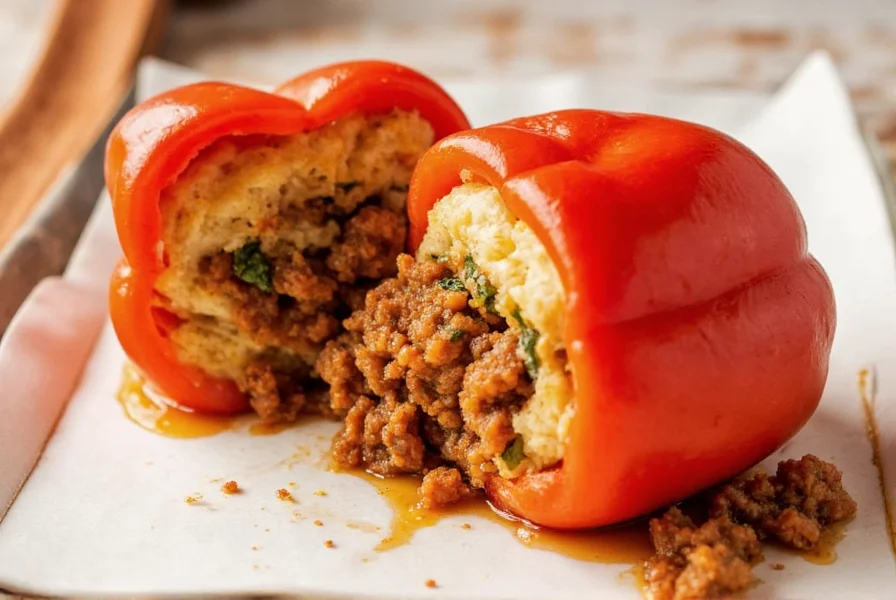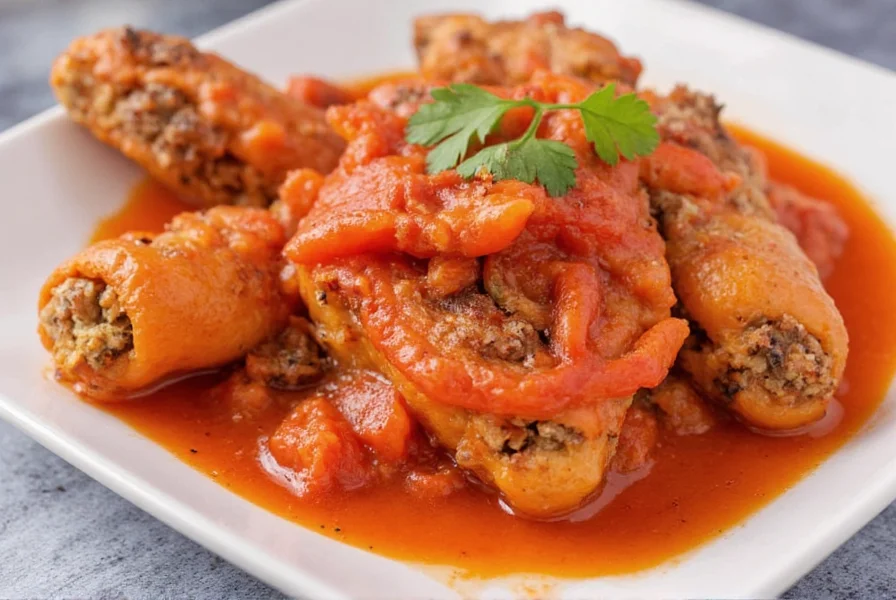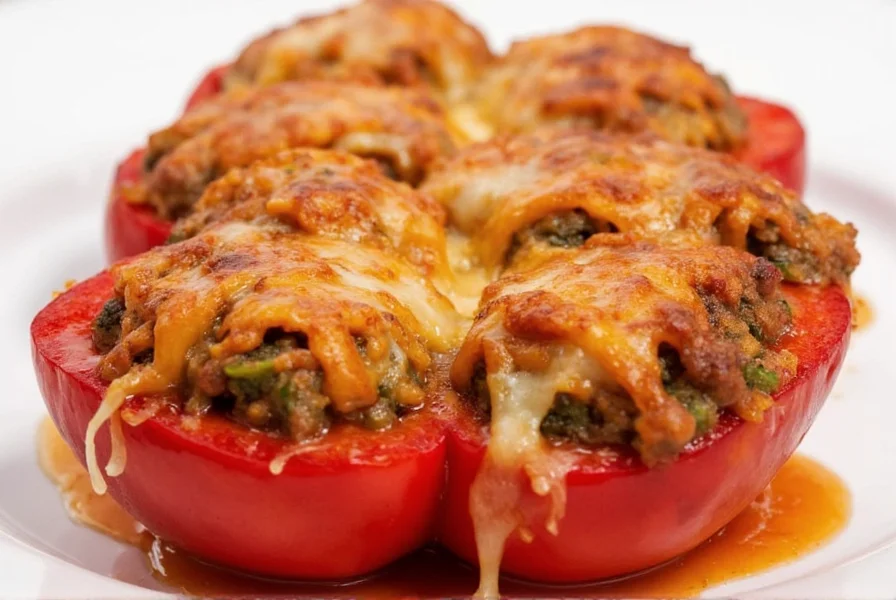For centuries, stuffed paprika has been a cornerstone of Central and Eastern European cuisine, particularly in Hungarian cooking where it's known as töltött paprika. This humble yet sophisticated dish transforms simple bell peppers into culinary masterpieces through careful preparation and thoughtful ingredient combinations. Unlike stuffed bell peppers in other culinary traditions, authentic Hungarian stuffed paprika typically features a tomato-based sauce and specific spice blends that create its distinctive flavor profile.
The Cultural Journey of Stuffed Paprika
While many associate stuffed peppers with Italian or American cuisine, the Hungarian version of stuffed paprika has a rich history dating back to the 16th century when paprika itself was introduced to the region. The dish evolved as Hungarian cooks incorporated locally available ingredients, creating what would become a national treasure. Traditional Hungarian stuffed paprika differs from Mediterranean or Middle Eastern stuffed pepper variations primarily in its sauce base and spice profile.
Essential Ingredients for Authentic Stuffed Paprika
The magic of perfect stuffed paprika lies in ingredient quality and proper preparation technique. For an authentic Hungarian-style stuffed paprika, you'll need:
- Firm, fresh bell peppers (preferably dark green or red)
- Ground beef or a beef-pork mixture (80/20 ratio)
- Short grain rice (not converted rice)
- Sweet Hungarian paprika (the star ingredient)
- Onion, garlic, and tomato products
- Sour cream for serving (essential in Hungarian tradition)
When preparing stuffed paprika, the quality of your paprika makes or breaks the dish. Genuine Hungarian sweet paprika provides the distinctive flavor that defines this recipe, unlike generic "paprika" powder available in many supermarkets. For the most authentic stuffed bell peppers experience, seek out Hungarian paprika labeled "Édesnemes" (sweet noble).
| Regional Variation | Key Ingredients | Distinguishing Features |
|---|---|---|
| Traditional Hungarian | Beef, rice, sweet paprika, tomato sauce | Served with sour cream, often with csipetke (pinched noodles) |
| Serbian Punjene Paprike | Beef/pork mix, rice, paprika, ajvar | Often includes smoked meat, served with yogurt |
| Mediterranean Style | Lamb, bulgur, herbs, lemon | Lighter filling, often tomato-free |
| Vegetarian Adaptation | Quinoa, mushrooms, lentils, walnuts | Rich umami flavor without meat |
Step-by-Step Preparation Guide
Creating perfect stuffed paprika requires attention to detail at each stage. Follow these steps for restaurant-quality results at home:
- Prepare the peppers: Cut tops off bell peppers and remove seeds/membranes. Blanch in boiling water for 3-4 minutes to soften slightly while maintaining structure.
- Create the filling: Brown meat with onions, then mix with cooked rice, paprika, salt, and pepper. Let cool before stuffing.
- Stuff carefully: Fill peppers without overpacking (rice expands during cooking). Leave ½ inch space at the top.
- Arrange for cooking: Place stuffed peppers upright in a heavy pot with tomato base sauce on bottom.
- Simmer gently: Cover with additional sauce, add broth to come halfway up peppers, and simmer covered for 45-60 minutes.
Avoiding Common Stuffed Paprika Mistakes
Even experienced cooks encounter challenges with stuffed paprika. Here's how to avoid the most frequent issues:
- Soggy peppers: Blanching time is critical—too long and peppers fall apart, too short and they remain tough. Test one pepper first.
- Collapsed fillings: Use short-grain rice which holds its shape better than long-grain varieties when cooked inside peppers.
- Bland flavor: Bloom paprika in warm oil before adding to filling to maximize flavor extraction.
- Peppers tipping over: Create a small slice on the bottom to create a flat surface for stability during cooking.
Serving Suggestions and Pairings
Authentic Hungarian stuffed paprika traditionally accompanies csipetke (small pinched noodles) that cook in the sauce alongside the peppers. For modern presentations, consider these pairings:
- Fresh cucumber salad with dill and sour cream
- Crusty bread for soaking up the flavorful sauce
- Light green salad with lemon vinaigrette to cut richness
- Traditional Hungarian red wine like Kékfrankos
When serving stuffed paprika, always include a dollop of high-fat sour cream on top—a non-negotiable element in Hungarian culinary tradition that balances the dish's acidity and enhances the paprika flavor.
Vegetarian and Dietary Adaptations
For those seeking meatless stuffed paprika options, several satisfying adaptations maintain the dish's essence while accommodating dietary preferences:
- Traditional vegetarian: Replace meat with finely chopped mushrooms, lentils, and walnuts for umami depth
- Gluten-free: Use certified gluten-free broth and ensure all packaged ingredients meet requirements
- Vegan: Substitute sour cream with cashew cream and use vegetable broth
- Low-carb: Replace rice with cauliflower rice or quinoa for reduced carbohydrates
When adapting stuffed bell peppers for special diets, maintain the critical balance of flavors—sweet peppers, tangy tomato base, and warm paprika notes should remain prominent regardless of ingredient substitutions.

Storage and Reheating Techniques
One of stuffed paprika's advantages is how its flavors improve with time. Proper storage ensures optimal taste when enjoying leftovers:
- Cool completely before refrigerating (within 2 hours of cooking)
- Store peppers and sauce together in airtight containers
- Refrigerate for up to 4 days or freeze for up to 3 months
- Reheat gently in sauce to maintain pepper integrity
When reheating stuffed paprika, add a splash of broth or water to refresh the sauce. Microwave reheating often makes peppers rubbery—gentle stovetop reheating preserves texture best. Frozen stuffed peppers should be thawed overnight in the refrigerator before reheating.

Perfecting Your Stuffed Paprika Technique
Mastering stuffed paprika requires understanding how small adjustments create significant improvements. Consider these professional tips for elevated results:
- Choose peppers with flat bottoms that stand upright without tipping
- Use a combination of sweet and smoked paprika for complex flavor
- Add a pinch of sugar to the sauce to balance tomato acidity
- Let stuffed peppers rest 10 minutes after cooking before serving
- Use a heavy-bottomed pot for even heat distribution during simmering
The difference between good and exceptional stuffed paprika often comes down to patience—allowing the dish to develop flavors through proper simmering time and resting before serving. Authentic Hungarian stuffed paprika recipes emphasize slow cooking to let flavors meld beautifully.
What's the difference between stuffed paprika and stuffed bell peppers?
While often used interchangeably, stuffed paprika specifically refers to the Hungarian preparation featuring paprika as a primary flavoring ingredient in both the filling and sauce. Stuffed bell peppers is a broader term encompassing similar dishes across various cuisines that may not necessarily feature paprika prominently. Authentic Hungarian stuffed paprika always includes sweet paprika as a defining ingredient.
Can I make stuffed paprika ahead of time?
Yes, stuffed paprika actually improves when made ahead. Prepare and cook the dish completely, then refrigerate overnight. The flavors deepen as they meld. When ready to serve, reheat gently on the stovetop with a splash of broth. Many Hungarian families consider stuffed paprika a perfect make-ahead dish for entertaining or meal prep.
Why does my stuffed paprika filling shrink during cooking?
Filling shrinkage typically occurs when the rice hasn't been partially cooked before stuffing. For best results, use par-cooked rice (about 70% done) in your filling mixture. This prevents excessive expansion that pushes against the pepper walls. Additionally, don't overpack the peppers—leave about half an inch of space at the top for the filling to expand during cooking.
What's the best type of bell pepper for stuffed paprika?
Firm, thick-walled bell peppers work best for stuffed paprika. Dark green peppers offer classic flavor and hold their shape well, while red peppers provide natural sweetness that complements the paprika. Avoid thin-walled or overly ripe peppers which may collapse during cooking. Look for peppers with flat bottoms that stand upright without tipping in the cooking vessel.
Can I freeze stuffed paprika?
Yes, stuffed paprika freezes exceptionally well. Cool completely, then store in airtight containers with peppers and sauce together. Freeze for up to 3 months. Thaw overnight in the refrigerator before reheating gently on the stovetop. The texture holds up remarkably well after freezing, making it an excellent make-ahead dish for future meals.











 浙公网安备
33010002000092号
浙公网安备
33010002000092号 浙B2-20120091-4
浙B2-20120091-4